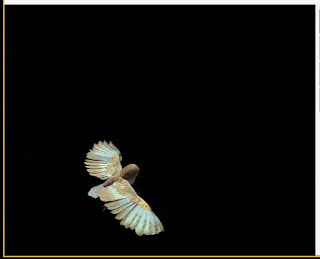But what are they though? A question only asked by the most compulsive of birders, sure, but one still worth considering, at least academically. Could a bird ornament be IDed? It turns out there's a lot of variety in how much veracity these ornaments have. The core philosophies of creation seem to range from extremely intentional recreation of a specific species to "make a bird". Today we're going to be looking at a couple of examples. Pull a cozy chair up to the fireplace and sip your hot cocoa as you join us for this pedantic holiday exercise.
As a fun bonus we're going to be running the very impressive Merlin Bird ID app through its paces to see if it can offer any additional insights beyond my own arcane system.
Key Features: Drab coloration, rufous crown, brown streak across chest, sparrow-shaped
Best Guess: Bachman's SparrowMerlin says: Brown Thrasher
 |
| illustrated images copyright whatbird.com |
I feel it's clear they were going for a certain type of bird at least, but how much further they went than that is anybody's guess. There are a few defining features that could be used for identification, but sadly most of them rule out real birds. The yellow eye is most damning, but the small black beak also doesn't help. At this point it's worth noting that many bird ornaments don't have feet, but rather flexible wires, which to my knowledge is not consistent with any known bird species. Still, the red crown and brown streaked breast make me fairly confident of my identification. This raises another question however- why would anyone make an ornament that looks like a Bachman's Sparrow?
Ornament Rating: 🐦🐦🐦
Key Features: Prominent red coloration, black features including crown, chest, eye stripe [left]
Yellow head, black, curved bill, blue wing spot [right]
Best Guesses: Cardinal [left] Yellow-headed Blackbird [right]
Merlin Says: Northern Red Bishop [left] Yellow-throated Toucan [right]


Terrible, just terrible, in both cases. The red bird, to me, is clearly meant to represent a Cardinal (the crest really gives it away), a really Christmas-y bird. However, it's got these needless features that make it completely incompatible with any real bird. If you were already 90% of the way to making a serviceable cardinal, why would you make a black crest and eye stripe? The other bird is just as bad, having a combination of colors and body shape that make it mostly impossible. The most prominent feature is the yellow head and dark body, which rules out pretty much everything other than the Yellow-headed blackbird all by itself. You could be extremely generous and assume that the blue wing is a kind of opalescent sheen that you can sometimes seen on black birds. I did find some examples of budgies with yellow heads and blue bodies, but the tail and beak take this too far away from the essential shape of the bird to be what they intended.
Ornament Ratings: 🐦 (each scored half a bird, together they get 1)
Key Features: Owl shape, prominent white mask, black eye ring, dark wings
Best Guess: Northern Saw-whet Owl
Merlin Says: Northern Saw-whet Owl (We got one!!)
 |
Ornament Ratings: 🐦🐦🐦🐦
Key Features: Bluish back, yellow belly, white eye mask, upturned tail
Best Guess: Blue Tit
Merlin says: Bananaquit (?!)
 |
Ornament Ratings:🐦🐦🐦🐦
Key Features: Silvery-grey, prominent tuft, black beak, darker wing
Best Guess: Black-crested Titmouse
Merlin Says: Black-crested Titmouse!
 |
Ornament Ratings:🐦🐦🐦🐦
Key Features: White, crested, black ring around the neck, spotted wings, striped tail
Best Guess: Leucistic Bluejay
Merlin Says: Mourning Dove
 |
Ornament Ratings:🐦🐦🐦🐦🐦
There you have it birdfans. Now you have all the example you need for how to irritate your friends and relatives by flailingly 'identifying' the birds hanging on your own tree at Christmastime. And I was pretty impressed by Merlin as well, although it's got a long way to go before I can start using it to identify pokemon and stuff.











































